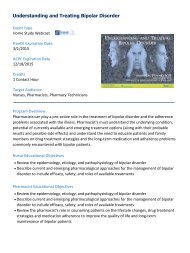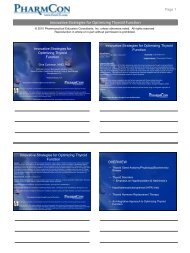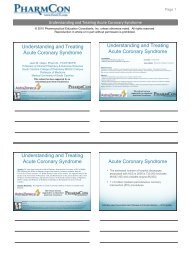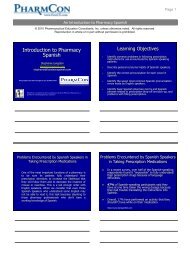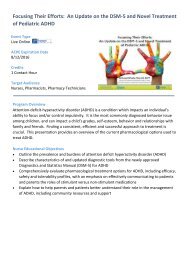Carbohydrate Counting for pediatric patients with type 1 diabetes
Carbohydrate Counting for pediatric patients with type 1 diabetes
Carbohydrate Counting for pediatric patients with type 1 diabetes
You also want an ePaper? Increase the reach of your titles
YUMPU automatically turns print PDFs into web optimized ePapers that Google loves.
Program ObjectivesAt the end of the session Registered Nurseswill be able to:• Define carbohydrate counting• Identify categories of foods containing carbohydrate• Identify the relationship between carbohydrates andblood sugar• Determine the grams of carbohydrate in foods whenusing the nutritional food label and other carbohydratecounting tools• Calculate the total grams of carbohydrate per meal
Benefits of <strong>Carbohydrate</strong> <strong>Counting</strong>• It is more flexible than other mealplanning methods• Sugar is not <strong>for</strong>bidden• It focuses attention on the foods whichare most likely to make blood glucoselevels go up
Foods that Contain <strong>Carbohydrate</strong>s• Breads, cereals, pasta, and grains• Rice, beans, and starchy vegetables(potatoes, corn, peas)• Fruit and fruit juices• Milk and yogurt• Regular soda, fruit drinks, jelly beans,gum drops• Cakes, cookies, chocolate candy
Grams of <strong>Carbohydrate</strong> Per FoodCategory15• Starch and Fruit: one serving equals about 15grams of carbohydrate• Milk: one serving equals about 12 grams ofcarbohydrate• Vegetables: one serving equals about 5 gramsof carbohydrate*Please see handout on carbohydrate foods
Starches
Starch GroupEach amount listed below= 15 grams ofcarbohydrate1oz of bagel, bread, roll (1 slice of bread, ¼ of bagel)¾ cup unsweetened cereal (cheerios, rice krispies, corn flakes)1/3 cup of higher carbohydrate cereals (raisin bran)½ English muffin1/3 cup of cooked pasta, spaghetti, macaroni and cheese1/3 cup of cooked brown or white rice½cup mashed potatoes½ cup corn, beans, chickpeas, peas1 small baked potato (3oz)
Fruits and Fruit Juices
Fruit GroupEach amount listed below= 15 grams ofcarbohydrate1 small fresh fruit (4 oz)½ cup canned fruit (in natural juice)2 tablespoons of raisins17 grapes½cup fruit juice1 cup cut up fresh fruit1 tablespoon of jelly, jam
Milk and Yogurt
Milk GroupEach amount listed below= approximately 12 grams ofcarbohydrate8 oz of skim, 1%, 2%, or whole milk1 cup of plain yogurt1 cup of plain or vanilla soy milk
Vegetables
VegetablesVegetables are counted as 5 grams ofcarbohydrate <strong>for</strong> the followingservings sizes:½ cup of cooked vegetables OR1 cup of raw vegetables
Foods Without <strong>Carbohydrate</strong>The protein and fat group contain 0 gramsof carbohydratesExamples:Protein: Meat, fish, poultry, cheese, eggs,peanut butter, cottage cheese, tofuFat: Butter, oils, margarine, mayonnaise,cream cheese, sour cream, nuts, seeds,avocado, salad dressing
<strong>Carbohydrate</strong> and Non -<strong>Carbohydrate</strong> CategoriesGroups/ ListsCHOProteinFatCaloriesStarch1531 orless80Fruit150060MilkSkimLow-fatWhole1212128880-35890120150Other carbohydrates12variesvariesvariesVegetables52025Meat and Substitute GroupVery leanLeanMedium-fatHigh-fat000077770-1358355575100Fat Group00545
The Relationship Between<strong>Carbohydrate</strong> and Blood Sugar• The digestive system converts most digestiblecarbohydrates into glucose (also known as bloodsugar)• Cells are designed to use this as a universalenergy source• As blood sugar levels rise, in a non-diabeticindividual beta cells in the pancreas churn outmore and more insulin, a hormone that signalscells to absorb blood sugar <strong>for</strong> energy or storage
<strong>Carbohydrate</strong> and Blood Sugar inDiabetes• People <strong>with</strong> <strong>type</strong> 1 <strong>diabetes</strong>, the pancreas does notmake any insulin so their cells can't absorb sugar• People <strong>with</strong> <strong>type</strong> 2 <strong>diabetes</strong> the pancreas does not makeenough insulin or the insulin is not effective because thecells are insulin resistant• <strong>Carbohydrate</strong>s begin to raise blood glucose <strong>with</strong>inapproximately 5 minutes after initiation of food intake• <strong>Carbohydrate</strong>s are converted to nearly 100% bloodglucose <strong>with</strong>in about two hours
<strong>Carbohydrate</strong> and Blood Sugar inDiabetes• The focus of carbohydrate counting is onthe one nutrient that most impacts bloodglucose• <strong>Carbohydrate</strong> is the primary nutrientaffecting blood glucose levels• People can learn to relate carbohydrateintake <strong>with</strong> their blood glucose results
<strong>Carbohydrate</strong> and Blood Sugar inDiabetes• All <strong>patients</strong> <strong>with</strong> <strong>diabetes</strong> should test theirblood glucose be<strong>for</strong>e and 2 hours after thefirst bite of the meal• This is the only way to tell how thechoices and amount of carbohydrates theyconsumed effect their blood sugar
Blood Sugar Target Ranges• Fasting/be<strong>for</strong>e meals: 90-130 mg/dl• After meals (2 hours after the 1 st bite):
<strong>Carbohydrate</strong> and Blood Sugar inDiabetes- Example• Mr. S consumed 90 g of carbohydrate <strong>for</strong>breakfast (day 1)– Blood sugar pre-meal= 115 mg/dl– Blood sugar post-meal = 205 mg/dl• Mr. S consumed 45 g of carbohydrate <strong>for</strong>breakfast (day 2)– Blood sugar pre-meal= 125 mg/dl– Blood sugar post-meal = 150 mg/dl
<strong>Carbohydrate</strong> Substituting• When carbohydrate counting, one fooditem can be substituted <strong>for</strong> another <strong>for</strong> asimilar impact on blood glucose• Example: a small apple (4oz) can beexchanged <strong>for</strong> 2 small cookies <strong>for</strong> a similareffect on blood glucose
Food LabelsTotal <strong>Carbohydrate</strong> includesgrams of sugar, sugaralcohol, starch, anddietary fiberTotal Grams of CHOTo determine amount ofcarbohydrate eaten,multiply grams of totalcarbohydrates on thelabel by the number ofservings eaten
Food Labels• Example: You just ate 10 crackers fromthe previous label• There are 2 crackers per serving• How many servings did you eat? 5• How many total carbohydrates did youconsume?– 10 g per serving x 5 servings= 50 grams
Tools <strong>for</strong> <strong>Carbohydrate</strong> <strong>Counting</strong>Nutrition LabelsMeasuring Tools
<strong>Carbohydrate</strong> <strong>Counting</strong> Hand Guide
<strong>Carbohydrate</strong> allowances <strong>for</strong> mealsand snacks• Every patient <strong>with</strong> <strong>diabetes</strong> should work <strong>with</strong> aRegistered Dietitian or Certified DiabetesEducator to receive an individualized meal planwhich will include how many total carbohydratesthey should consume at meals and snacks• A general guideline <strong>for</strong> <strong>patients</strong> would be 45-60grams per meal and 15-30 grams per snack
Sample Menu Breakfast1 ½ cup of cheerios=?Small banana (4 oz)=?8 oz 1% milk=?1 egg =?How many carbohydrates are in this meal??*See handout
Sample Menu Breakfast Answers1 ½ cup of cheerios= 30 gramsSmall banana (4 oz)= 15 grams8 oz 1% milk= 12 grams1 egg = 0 gramsTotal= 52 grams
Sample Menu Lunch2 slices of bread=?17 grapes=?1 cup of raw carrots=?3 oz tuna fish=?1 tsp mayonnaise=?How many carbohydrates are in this meal??*See handout
Sample Menu Lunch Answers2 slices of bread=30 grams17 grapes=15 grams1 cup of raw carrots=5 grams3 oz tuna fish= 0 grams1 tsp mayonnaise= 0 gramsTotal= 50 grams
Sample Menu Dinner1 ½ cups of pasta= ?1 oz of bread=?1 cup of salad =?1 tsp of olive oil= ?How many carbohydrates are in this meal??*See handout
Sample Menu Dinner Answers1 ½ cups of pasta= 68 grams1 oz of bread=15 grams1 cup of salad =5 grams1 tsp of olive oil= 0 gramsTotal = 88 grams
Conclusions• <strong>Carbohydrate</strong> counting is a meal planningapproach to help people <strong>with</strong> <strong>diabetes</strong> attain andmaintain glycemic control• <strong>Carbohydrate</strong> counting can help people enjoy aflexible eating plan• People <strong>with</strong> <strong>diabetes</strong> require education and skilldevelopment in order to learn carbohydratecounting
Thank you!Questions?



